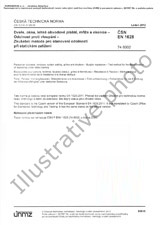We need your consent to use the individual data so that you can see information about your interests, among other things. Click "OK" to give your consent.
ČSN EN 13852-3 (270560)
Cranes - Offshore cranes - Part 3: Light offshore cranes
Translate name
STANDARD published on 1.9.2021
The information about the standard:
Designation standards: ČSN EN 13852-3
Classification mark: 270560
Catalog number: 512538
Publication date standards: 1.9.2021
SKU: NS-1034723
The number of pages: 114
Approximate weight : 373 g (0.82 lbs)
Country: Czech technical standard
Category: Technical standards ČSN
The category - similar standards:
Annotation of standard text ČSN EN 13852-3 (270560):
This document applies to light offshore cranes including their supporting pedestals and structures.
NOTE - Supporting pedestal and structures such as columns and boom rests, are covered by this document to the extent where their main purpose is to support the crane.
This document is applicable to light offshore cranes, whose structures are made of steel, and fulfil all of the following characteristics:
- - maximum rated capacity 15 tonnes or maximum static load moment 3 000 kNm;
- - limitation for off-board lifting operation up to Hs = 2,0 m and wind speed 15 m/s (3 s gust);
- - maximum number of working cycles class U1 (C <= 3,15 × 10E4) according to EN 13001-1.
This document provides requirements for all significant hazards, hazardous situations and events relevant to light offshore cranes for lifting of goods and lifting of persons, when used as intended and under conditions foreseen by the risk assessment (see Clause 4).
This document is applicable to light offshore cranes, which are manufactured after the date of approval by CEN of this document.
This document is not applicable for:
- a) transportation, assembly, disabling, scrapping, installation or erecting of the crane;
- b) any item attached to the hook, such as loads, non-fixed load lifting attachments, lifting accessories, baskets, carriers and containers;
- c) lifting operations in ambient temperatures below -20 °C;
- d) lifting operations in ambient temperatures above 45 °C;
- e) lifting operations involving more than one crane;
- f) accidental loads as result of collisions, earthquakes, explosions, etc., which are not covered by exceptional loads defined in Table B.7;
- g) emergency personnel rescue operations (except training);
- h) subsea lifting operations;
- i) general purpose offshore cranes (covered by EN 13852 1), floating cranes and motion compensated cranes
Preview of the standard ČSN EN 13852-3 (270560)
We recommend:
Updating of laws
Do you want to be sure about the validity of used regulations?
We offer you a solution so that you could use valid and updated legislative regulations.
Would you like to get more information? Look at this page.




 Cookies
Cookies
